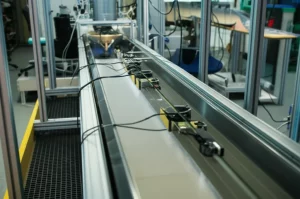Digital Twins: Picking the Winners for Your Service Game – A No-Nonsense Guide!
Hey there! Ever feel like you’re drowning in data but starving for wisdom? Especially when it comes to these fancy “digital twins” everyone’s talking about? You know, those virtual copies of your products or processes that promise to unlock all sorts of efficiencies. The potential is HUGE, especially for manufacturers using all that time series data from sensors and simulations. But here’s the rub: a lot of companies, and I mean a lot (like 80%!), aren’t really cashing in on their data. It’s like having a supercomputer and only using it to play Solitaire.
The big problem? Often, there’s a massive gap between collecting tons of data and actually using it in smart, data-driven ways to achieve specific goals. What’s missing is a solid “data-to-value” game plan. We need a way to figure out which digital twin applications are actually worth the sweat and which ones are just shiny objects. That’s where I come in, or rather, where this cool methodology I want to talk about comes in!
This isn’t just another academic paper gathering dust. We’re talking about a practical approach to quantify how suitable different data-driven applications are, all based on a clear-eyed look at their potential value and the effort it’ll take to get them off the ground. Think of it as a matchmaker for your data and your business goals, especially for those in manufacturing who want to pick the best digital twin application for their specific needs, particularly in the product service phase.
So, What’s the Big Idea?
Alright, let’s get down to brass tacks. We’re looking at the “product service phase” – that’s everything that happens after a product is made: distribution, how it’s used, repairs, maintenance, the whole shebang. Digital twins can be rockstars here, helping to, say, predict when a machine part needs servicing before it breaks down, or optimizing how a product is used to save energy.
The core of this methodology is about making smart choices when the economic value and effort aren’t immediately obvious. We’re not just throwing darts in the dark. Instead, we’re systematically evaluating potential digital twin applications. The beauty of this approach, and what makes it a bit of a game-changer, is that it lets companies, especially small and medium-sized ones (SMEs, I’m looking at you!), assess different scenarios without needing to pull exact monetary figures out of thin air right at the start. This is super valuable because, let’s be honest, who really knows the precise ROI of a new tech before it’s even implemented?
This methodology has three main parts, and we’ll walk through them. But first, a quick nod to some of the brainy tools we’re using.
The Nerdy (But Necessary) Bits: ANP and TOPSIS
To make these decisions, we lean on a couple of established methods. Don’t worry, I’ll keep it simple!
- Analytic Network Process (ANP): Imagine you’re trying to decide on the best holiday. It’s not just about cost, right? It’s about weather, activities, travel time, and how these things might influence each other. ANP is great for these kinds of multi-criteria decisions where everything is interconnected. It helps us weigh up different “value aspects” (like improving product quality or cutting costs) and see how they play together.
- Technique for Order of Preference by Similarity to Ideal Solution (TOPSIS): This one sounds like a mouthful, but the idea is straightforward. Once we’ve figured out the value and effort for each potential digital twin application, TOPSIS helps us rank them. It finds the application that’s closest to the “perfect” solution (high value, low effort) and furthest from the “worst” solution (low value, high effort).
We also sprinkle in a bit of Fuzzy Logic. Real-world decisions are rarely black and white; there’s a lot of “maybe” and “sort of.” Fuzzy logic helps us translate those human, slightly vague judgments (like “this is pretty important”) into numbers our models can work with. It’s like adding shades of grey to a black-and-white picture, making it more realistic.

Now, before we dive into the methodology itself, what kind of “data-driven applications” are we even talking about? In the context of digital twins, these are applications that use all that lovely time series data (think sensor readings over time) and analytical methods (like machine learning or good old statistical models) to make things better. We’re focusing on the service phase here. Think about things like:
- Service 1: Product quality monitoring and prediction: Using data to spot potential defects early or even predict product quality before it’s made.
- Service 2: Process monitoring and control: Keeping an eye on the manufacturing process itself to make it more reliable and less costly.
- Service 3: Resource consumption optimisation: Finding ways to use less energy or materials.
- Service 4: Product life cycle assessment and optimisation: Understanding and improving the environmental footprint of a product.
- Service 5: Predictive maintenance and remaining useful life prediction: Guessing when a machine or part will need maintenance to avoid nasty surprises.
We’ve carefully selected these five, refining them from a broader list to focus on applications that really leverage data and models to characterize a physical object and deliver tangible benefits, rather than, say, virtual training tools.
The Three-Step Dance to Digital Twin Success
Okay, here’s the core of it – our three-step decision-making methodology. It’s all about giving you a structured way to pick the right digital twin application by looking at both the goodies (value) and the grind (effort).
Step 1: Quantifying the Value – What’s In It For Me?
First up, we figure out how much value each digital twin application could bring. We do this by identifying “value aspects.” These are the specific ways an application can make things better. We’ve grouped them into three main categories:
- Product Quality: Things like making better products (duh!), reducing defects, and improving quality control. Think VA1: Improvement of product quality, VA2: Minimisation of quality fluctuations, and VA3: Improved quality control.
- Process Quality: This is about making the manufacturing process itself smoother and more efficient. We’re talking VA4: Enhancement of process reliability and VA5: Reduction of process costs.
- Fulfilment of Regulatory Requirements: Let’s not forget keeping the regulators happy! This includes VA6: Fulfilment of sustainability standards, VA7: Traceability (knowing where your materials came from and what happened to them), and VA8: Assurance of product conformity.
We identified these value aspects through a good old-fashioned literature deep-dive. Then, using the ANP method I mentioned earlier, we do pairwise comparisons. This means asking questions like, “For our company, is improving product quality more important than reducing process costs right now?” This helps us put a number on the relative importance of these value aspects and see how they’re all connected. For instance, better process reliability (VA4) often leads to lower process costs (VA5). And improved quality control (VA3) is a big help in ensuring product conformity (VA8). These interdependencies are key, as fulfilling one value aspect can give another a nice boost!
Step 2: Assessing the Effort – How Hard Is This Going To Be?
Next, we look at the flip side: the effort involved. This isn’t just about money; it’s more nuanced. We consider two main things:
- Data-Related Effort: Do you actually have the time series data and Key Performance Indicators (KPIs) you need for a particular application? This includes the “sensory effort” (do you have the right sensors in place?) and the “effort for sensory process coverage” (if an application needs data from multiple manufacturing stages, how much of that can you cover?). We also look at the effort to collect the necessary process performance indicators.
- Technological Effort: This is about your company’s know-how. How good are you with data analysis methods, especially Machine Learning (ML)? We use something like the Technology Readiness Level (TRL) scale here. Also, for some applications (like Service 4, the life cycle assessment), you need specific competencies, like conducting a Life Cycle Assessment (LCA) according to ISO standards. And finally, are you willing and able to share data with partners if needed? Some applications really shine when data flows across company boundaries.
This part is also subjective because it depends on your company’s current setup, skills, and even culture around data sharing.

Step 3: The Grand Finale – Ranking with TOPSIS
Once we have our value scores and effort scores for each application, it’s time to bring it all together. Since value and effort are measured differently, we first normalize them – basically, putting them on a common scale from 0 to 1. This makes them comparable.
Then, we unleash TOPSIS. As I said, TOPSIS helps us find the application that’s closest to the dream scenario (maximum value, minimum effort) and furthest from the nightmare (minimum value, maximum effort). It spits out a ranking, giving you a clear, prioritized list of which digital twin applications are likely your best bets.
Let’s See It In Action: The Grinding Process Example
To show this isn’t just theory, let’s imagine a company that makes gears. Their process involves fine blanking, grinding, and milling. We’ll pretend we’re helping them pick a digital twin application for the service phase.
First, we’d sit down with them and do the ANP bit for value quantification. Let’s say they tell us that fulfilling regulatory requirements is super important, even more so than process quality, and product quality is equally vital. We’d then drill down into each value category. For product quality, maybe minimizing quality fluctuations (VA2) is their top concern.
We’d crunch these preferences, along with the pre-defined interdependencies between value aspects (like how better quality control improves product quality), through the ANP model. This gives us a numerical value for each of the eight value aspects (VA1 to VA8). Then, we sum up the values of the VAs that each of our five candidate services (Service 1 to Service 5) addresses. For example, “Service 1: Product quality monitoring and prediction” would get points for VA1, VA2, and VA3.
Next, effort assessment. Let’s assume this company only has time series data from their grinding process. We’d look at what sensors are needed for each service versus what they have. For “Service 1,” which needs full process coverage for best results, the fact they only have grinding data means higher effort for “sensory process coverage.” We’d also assess their ML skills (say, TRL 3 – they’ve done some experiments) and their experience with LCAs (maybe just Stage 1). If they do manual data sharing, that gets a certain effort score too.
Finally, with value and effort scores for all five services, we normalize them and run the TOPSIS analysis. This would give us a ranking. In our fictional example, “Service 1: Product quality monitoring and prediction” might come out on top as the most suitable, offering the best balance of value and effort for this specific company and their current situation.

So, What’s the Catch? And What’s Next?
Now, I’m not going to pretend this methodology is a silver bullet. It relies on expert opinions and weightings, which can bring in some subjectivity. It would be great to incorporate more hard, quantitative KPIs, but that needs more companies actually using these digital twin applications widely. Also, right now, we’re not explicitly factoring in implementation costs in monetary terms, which is obviously a big deal in the real world. Adding rough cost estimates could make it even more practical.
And, of course, it assumes you have decent quality time series data to begin with. If your data is messy or incomplete, that’s a whole other kettle of fish. Future work could definitely look at integrating a data quality check right into the model.
Despite these points, I think this approach is a really solid step forward. It gives companies a structured, transparent way to navigate the often-confusing landscape of digital twin applications. It helps bridge that “data-to-value” gap and empowers businesses to make more informed decisions, even when all the financial details aren’t crystal clear upfront.
The cool thing is, you can also use this to run “what-if” scenarios. What if we get more sensors? What if we upskill our team in ML? How would that change the value-effort picture? It’s a tool for thinking strategically about your digital twin journey.
Ultimately, understanding which application offers the best bang for your buck (or effort, in this case!) is the first step. After that, you can dive deeper into the quality of your data for that specific application and figure out which manufacturing targets to prioritize. It’s all about making your data work smarter, not just harder, to unlock the real power of digital twins in the service phase. And who wouldn’t want a piece of that action?
Source: Springer







